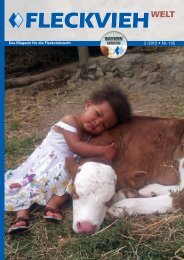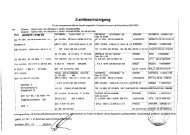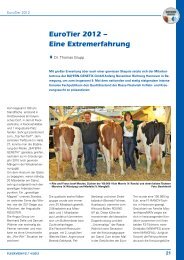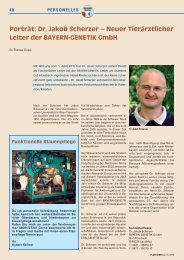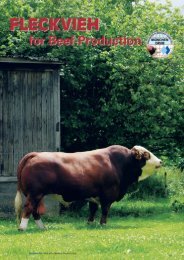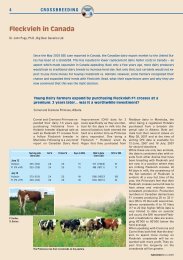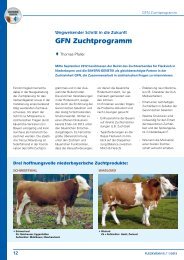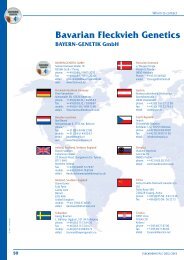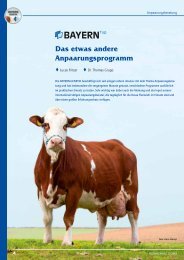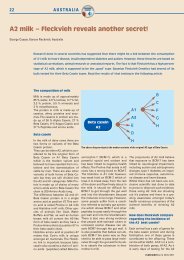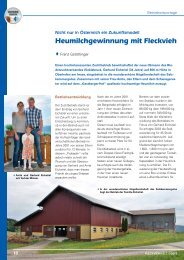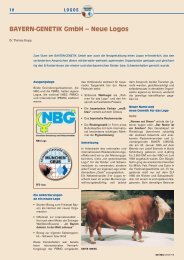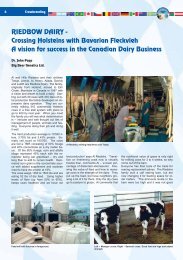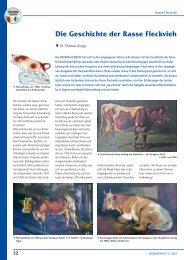Preliminary results on crossbreeding Jerseys with Fleckvieh sires
Preliminary results on crossbreeding Jerseys with Fleckvieh sires
Preliminary results on crossbreeding Jerseys with Fleckvieh sires
You also want an ePaper? Increase the reach of your titles
YUMPU automatically turns print PDFs into web optimized ePapers that Google loves.
Jersey heifers <strong>with</strong> <strong>Fleckvieh</strong> <strong>sires</strong>,<br />
because of the possibility of<br />
distokia from larger than normal<br />
birth weights of calves, heifers<br />
and first lactati<strong>on</strong> cows were also<br />
inseminated <strong>with</strong> <strong>Fleckvieh</strong> semen<br />
because of a small number of experimental<br />
animals in the herd.<br />
From the first round of inseminati<strong>on</strong>s,<br />
63 Jersey cows had calved<br />
down resulting in 28 purebred Jersey<br />
calves and 26 <strong>Fleckvieh</strong> x Jersey<br />
calves (Table 1).<br />
The overall birth weights of <strong>Fleckvieh</strong><br />
x Jersey calves were heavier<br />
than that of Jersey calves, i.e. 31.9<br />
vs 26.4 kg.<br />
At the last weighing date (August<br />
2007), Jersey calves were older<br />
(6.2 vs 5.1 m<strong>on</strong>ths) explaining the<br />
heavier liveweight of <strong>Jerseys</strong> in<br />
comparis<strong>on</strong> to <strong>Fleckvieh</strong> x Jersey<br />
calves. This is related to the chr<strong>on</strong>ological<br />
date of inseminati<strong>on</strong>s of<br />
cows. C<strong>on</strong>sidering each calf’s average<br />
daily gain and birth weight,<br />
the calculated live weight of <strong>Fleckvieh</strong><br />
x Jersey calves at 6 m<strong>on</strong>ths<br />
of age was 25 % higher than that<br />
of purebred Jersey calves. It<br />
seems that under similar feeding<br />
c<strong>on</strong>diti<strong>on</strong>s, <strong>Fleckvieh</strong> x Jersey heifer<br />
calves tend to grow at a growth<br />
rate almost similar to that of Jersey<br />
bull calves. The feeding level<br />
of diets provided to crossbred heifers<br />
should probably be lower<br />
than for purebred heifers to prevent<br />
excess fat depositi<strong>on</strong> in the<br />
udder of heifers as that could have<br />
a negative effect <strong>on</strong> the milk yield<br />
of cows after first calving.<br />
Table 2:<br />
FLECKVIEHWorld 2008<br />
The number of calves born according<br />
to lactati<strong>on</strong> number and gender<br />
since the start of the experiment<br />
is presented in Table 2.<br />
Although informati<strong>on</strong> is available<br />
<strong>on</strong> a small number of calves, it<br />
seems that birth weight increases<br />
<strong>with</strong> lactati<strong>on</strong> number and gender.<br />
Three and five calves sired by Jersey<br />
and <strong>Fleckvieh</strong> bulls died during<br />
birth. These were mostly bull<br />
calves, i.e two <strong>Jerseys</strong> and four<br />
crossbreds. These were larger<br />
than normal bull calves, i.e. in excess<br />
of 45 kg. The proporti<strong>on</strong> of<br />
dead calves was similar for first<br />
parity in comparis<strong>on</strong> to older<br />
cows. The number of calves surviving<br />
after birth was similar for<br />
both sire breeds. While Jersey<br />
cows are known for their ability<br />
for easy calving, close attenti<strong>on</strong> of<br />
cows at calving should always be<br />
a high priority. The birth weights<br />
of heifer and bull calves in relati<strong>on</strong><br />
to dam live weights were 5.6 and<br />
6.4 % for <strong>Jerseys</strong> and 6.9 and<br />
7.1 % for <strong>Fleckvieh</strong> x Jersey crossbreds<br />
indicating the effect of gender<br />
and breed.<br />
C<strong>on</strong>clusi<strong>on</strong><br />
This project is still at a very early<br />
stage and <str<strong>on</strong>g>results</str<strong>on</strong>g> obtained should<br />
be interpreted <strong>with</strong> care. The main<br />
emphasis of the project is based<br />
<strong>on</strong> the milk yield and reproductive<br />
performance of crossbred cows in<br />
comparis<strong>on</strong> to purebred <strong>Jerseys</strong>.<br />
Those <str<strong>on</strong>g>results</str<strong>on</strong>g> are still a l<strong>on</strong>g way<br />
off.<br />
The number and birth weights of calves and dam live<br />
weights before calving sired by <strong>Fleckvieh</strong> and Jersey bulls<br />
Parity of Jersey <strong>Fleckvieh</strong><br />
Parameters dams Heifers Bulls Heifers Bulls<br />
Number of calves born 1 4 2 4 4<br />
2 6 4 4 1<br />
3+ 7 5 5 9<br />
Birth weight (kg) 1 24.0 25.9 27.4 30.8<br />
2 24.1 26.0 30.4 34.0<br />
3+ 27.8 29.8 34.6 33.6<br />
Dam live weight (kg) 1 425 367 408 399<br />
2 477 446 458 341<br />
3+ 469 460 490 510<br />
CROSSBREEDING 9<br />
Standardized c<strong>on</strong>diti<strong>on</strong>s during the milk-feeding<br />
period<br />
Hippo-twins out of a Jersey cow. The white<br />
spots <strong>on</strong> their heads are typical for F1 <strong>Fleckvieh</strong><br />
x Jersey (50 % <strong>Fleckvieh</strong>)



